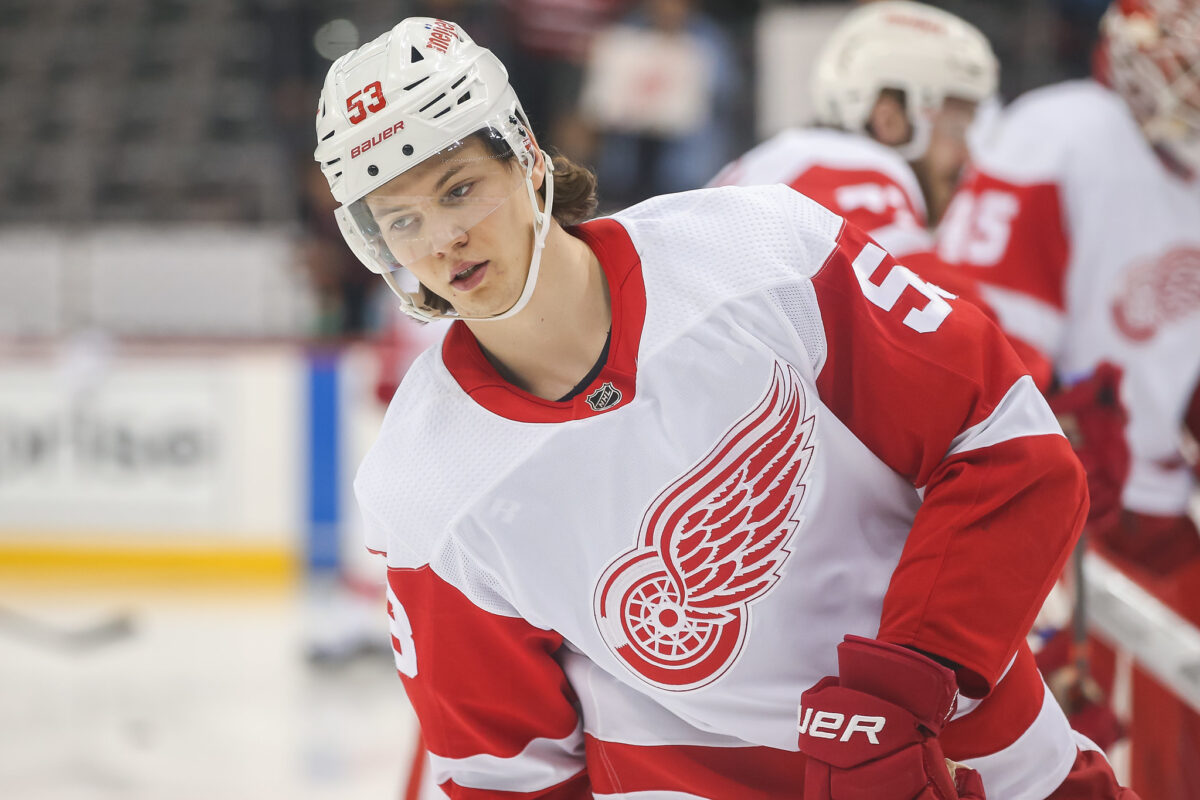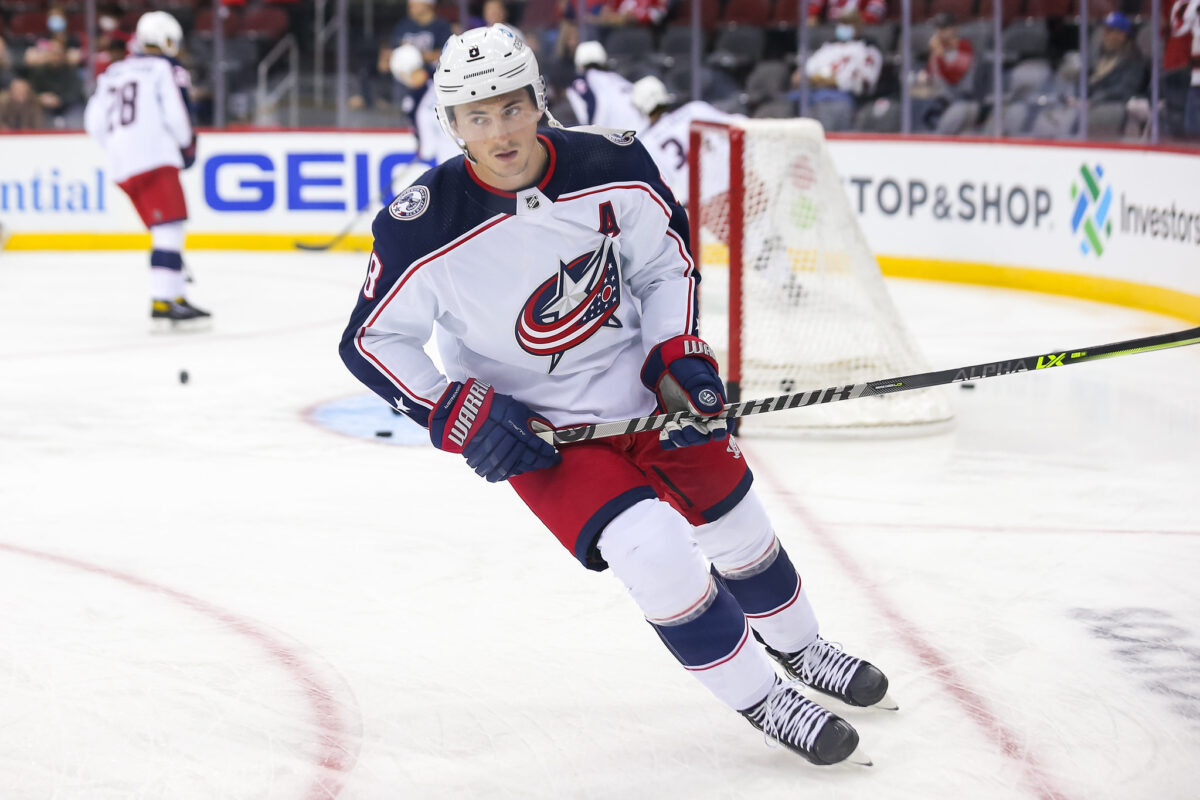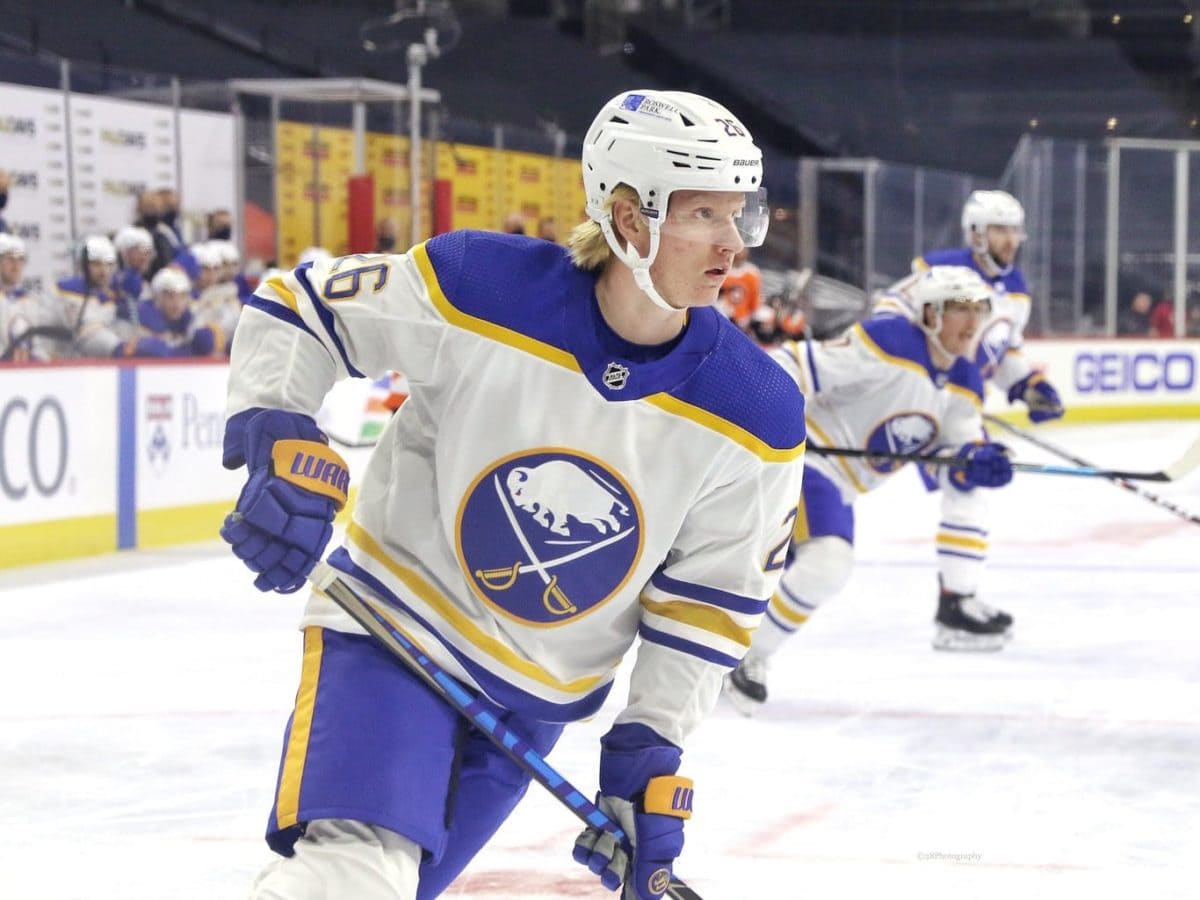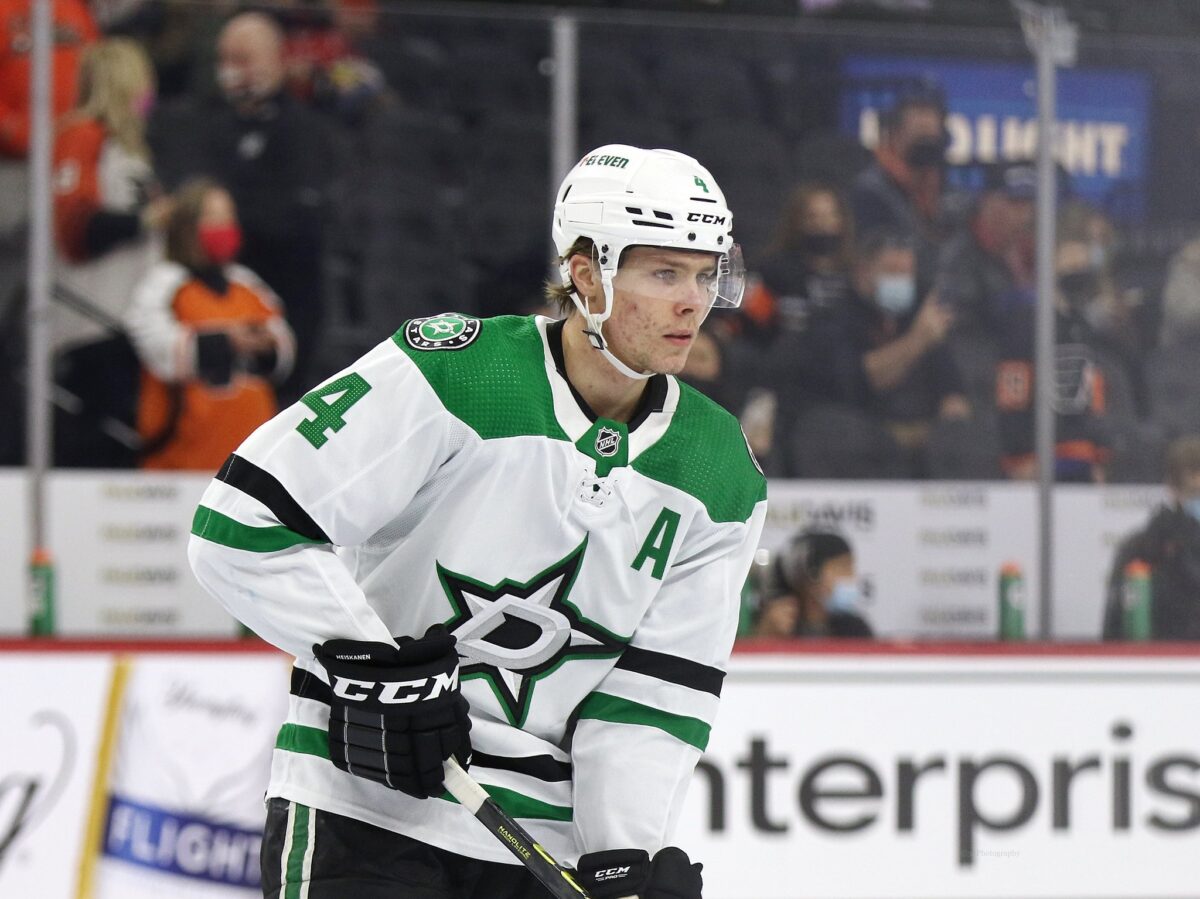Detroit Red Wings defenceman Moritz Seider had a remarkable rookie season this year, quickly cementing himself as the top defender on a young team. He earned top-pairing minutes as well as consistent time on the power play and penalty kill, all while playing above-average defence for such a young defenceman. Seider scored an impressive 21 power-play points this season even though the Red Wings had an atrocious year on the man advantage, only converting on 16.3% of their opportunities.
The 21-year-old Seider finished the season with 50 points in 82 games, good enough for fourth in rookie scoring. He was the highest scoring rookie defenceman in the NHL by a wide margin, leading the player in second place by nearly 20 points. Seider has done nothing but impress since his surprise selection at sixth overall in the 2019 Draft. He excelled in the American Hockey League (AHL) as an 18-year-old, was named the best defenceman in the Swedish Hockey League (SHL) at age 19 and is now the favourite to be named the top rookie in the NHL this season.

This season was an unequivocal success for Seider, so let’s look ahead to the future and see what kind of impact he can be expected to make going forward. We’ll look through some recent rookie defenders with similar rookie seasons and see how their careers panned out thereafter. I’ll start off here with some of Seider’s stats from this year and move on to the comparable players from around the league.
Moritz Seider – Detroit Red Wings
Rookie Stats (2021-22)
7 goals and 43 assists for 50 points in 82 games
No NHL rookie was more important to their team’s success this season than Seider, who had just under 1,900 minutes of ice-time as a rookie, nearly 300 more minutes than the next most played rookie. The Red Wings as a team scored an abysmal 37 goals while on the power play and Seider factored in on 21 of them, meaning he contributed to roughly 57% of all power-play goals that his team scored.
Zach Werenski – Columbus Blue Jackets
Rookie Stats (2016-17)
11 goals and 36 assists for 47 points
After being selected eighth overall in the stacked 2015 Draft, expectations were sky-high for Zach Werenski. He delivered on those expectations with an impressive 47-point rookie season where he played just over 20 minutes each game, which is certainly above average for a rookie defenceman. Werenski is known as a great offensive defenceman but has never earned a reputation for being solid defensively like his long-time teammate Seth Jones has.

Werenski has proven himself as a consistent 40+ point defenceman who can quarterback the powerplay on a Columbus Blue Jackets team that is relatively weak offensively. He still hasn’t developed into a high-end two-way defender but would be likely look better on a team where he wouldn’t have to carry so much of the defensive load.
Seider out-paced Werenski’s rookie season in terms of offense, defense and ice-time so it would seem that Werenski is a bit of a baseline for Seider’s potential. If he never receives an excellent linemate and stalls out both defensively and offensively (all of which seem highly unlikely at this point) then he could end up having a similar career to Werenski. However, the Red Wings are clearly on the upswing and have tons of excellent help coming for their d-corps so let’s keep looking.
John Klingberg – Dallas Stars
Rookie Stats (2014-15)
11 goals and 29 assists for 40 points
John Klingberg has had a similar career to Werenski at this point, although the expectations for Klingberg when he was a rookie were much lower considering he was a fifth-round pick. Klingberg shocked the hockey world as a no-name rookie who scored 40 points in 65 games for the Dallas Stars.
Klingberg’s career has been plagued with injuries and inconsistency. He has shown glimpses of Norris Trophy-caliber play but that was followed up by some of the worst seasons of his career. In the 2017-18 season, Klingberg scored 67 points and showed decent defensive results before seeing his point-totals drop off and his defensive play get sucked away into a black hole over the following four seasons.
This season, Klingberg scored 47 points in 74 games but had a career-worst minus-28. Seider’s defensive game is already developed to a higher level than Klingberg’s and his offensive game will likely improve over his first few seasons like Klingberg’s did. However, it would be surprising to see Seider’s offensive talents dry up in a similar way to the Stars’ stud defender. On to the next comparison.
Rasmus Dahlin – Buffalo Sabres
Rookie Stats (2018-19)
9 goals and 35 assists for 44 points
As he entered the NHL for his rookie season, expectations for Rasmus Dahlin were set impossibly high. After being selected first overall in the 2018 Draft, Dahlin was expected to take over the NHL and immediately help turn around the struggling Buffalo Sabres. While he didn’t reach those expectations, Dahlin still had an excellent rookie season, scoring 44 points in 82 games. His offensive potential was on full display in his rookie season, but so were some of his defensive deficiencies.

After a few up and down seasons where the Sabres remained stagnant, Dahlin broke out in the 2021-22 season with 53 points in 80 games. His fortunes changed around the same time that the Sabres organization saw its fortunes change. As soon as Jack Eichel was traded.
In the 2021-22 season, Dahlin showed a more mature offensive game as well as a significantly improved (though still below pre-draft expectations) defensive game. Seider had a similar situation to Dahlin’s rookie season this year where he was the youngest defender on the team but was relied on as one of his team’s most important players nevertheless. However, the similarities seem to end there as Seider’s defensive game in his rookie year is already superior to Dahlin’s in his fourth full NHL season, and their offensive games are relatively even, though I’d give the edge there to Seider.
Quinn Hughes – Vancouver Canucks
Rookie Stats (2019-20)
8 goals and 45 assists for 53 points
Here’s where the comparisons get interesting as we move from fringe all-star defenders plagued by inconsistency to the fringe superstar defenders who can completely change a team’s future.
Quinn Hughes had a remarkable rookie year where he managed 53 points in 68 games while playing heavy power-play minutes. His ability to rack up the points from the blue line was a revelation for the Vancouver Canucks, who have never had such a dynamic offensive defenceman in franchise history.
Related: Predicting Lucas Raymond’s Future Based on Rookie Season
When the Canucks lost perennially underrated defensive-defenceman Chris Tanev to the Calgary Flames in free agency, no player felt Tanev’s absence more than Hughes. Tanev was Hughes’ d-partner in his rookie season and was an excellent safety net for the offensively minded rookie. Hughes’ defensive metrics suffered from that loss in his second season, and many were asking if he was going to be the next Tyson Barrie or Keith Yandle, an offensive defenceman who cannot be trusted in the defensive zone. This year, Hughes proved that he could be a dominant number one defenceman in the NHL, scoring a career high 68 points and playing much better defensively.
I do believe that the ceiling to Seider’s offensive game is in the Quinn Hughes range of 60+ points each season. If he can reach that level and maintain it over his career, Seider would be remembered as one of the best defenders of this generation. However, there is more to Seider’s game than offence, so let’s look one last comparison.
Miro Heiskanen – Dallas Stars
Rookie Stats (2018-19)
12 goals and 21 assists for 33 points
Miro Heiskanen is one of the very few rookie defencemen who had more ice time each game than Seider did. Seider played an average of 23:03 minutes per game this year while Heiskanen averaged 23:07 minutes. While not a significant gap, this number does put into perspective the role and expectations for Heiskanen in his rookie season as the third overall pick in the 2017 Draft. It became clear early on that Heiskanen had earned the trust of the Dallas Stars coaching staff as he was often used in high pressure scenarios such as late in a game while his team was defending a lead or even on the penalty kill as a rookie.

It is entirely possible that Heiskanen’s ice time would have been higher in his rookie season if the Stars didn’t still have Klingberg leading the power play. Heiskanen is not known for being a dynamic offensive player, averaging just under 40 points per-82 games in his career. He has shown the ability to lead his team on offense and could see an increase in power-play usage next season if Klingberg leaves the Stars in free agency. Heiskanen is an excellent young defenceman who has certainly lived up to the expectations of a third overall pick, even though he was immediately followed in the draft by Cale Makar and Elias Pettersson.
Just as I said that Quinn Hughes was the offensive ceiling for Seider, I believe that Heiskanen is Seider’s defensive ceiling. If Seider maintained his offensive output from his rookie season but could improve his defensive game to the same level as Heiskanen, then he would be in a great spot as the number one guy on the Red Wings. Regarding role and team situation in their rookie seasons, I think that Heiskanen is the best comparison for Seider, though the Red Wings rookie seems primed for a lot more offensive success.
What Will Seider’s Future Look Like?
Very few rookie defencemen have scored at the rate that Seider did this last season, and most who did (Adam Fox, Cale Makar, etc.) are among the NHL’s elite defenders. If Seider is able to improve on his unbelievable rookie season and hopefully play on an improved power play, then he will easily vault himself into Norris Trophy talks as soon as next season.
I mentioned how Hughes’ offensive abilities are within reach for Seider as well as Heiskanen’s defensive brilliance. What would happen if he is able to reach both of those high benchmarks? Could the Red Wings have the next Nicklas Lidstrom on their hands? If Seider is able to even slightly improve both his offense and defense, then he could very well be in competition for the Norris Trophy for the next 10-15 years alongside Cale Makar.
I am confident that the Red Wings’ powerplay will improve over the next couple of seasons, which will lead to us seeing Seider put up even higher point totals on the man advantage. I also expect the Red Wings’ d-corps to improve significantly over the next two seasons with the addition of some excellent young prospects like William Wallinder and Simon Edvinsson as well as some savvy trades of free agent pickups.
With how I expect this Red Wings team to improve around him, my expectations for Seider’s sophomore season are as follows. I predict that he will score eight goals and 55 assists for 63 points in another 82-game season. Once he gets some more help on the defensive end, I expect Seider’s usage to decrease slightly overall which will likely lower his offensive counting stats, though I expect him to maintain a roughly 60-point per season pace for the first three or four seasons of his career.
Regardless of how his game changes over the next few years, Seider is no one-season wonder. He is already a number one defenceman who will thrive as his team gradually improves around him. He is a cornerstone piece of this Red Wings team as they make their way out of their rebuild and he is only going to get better.
